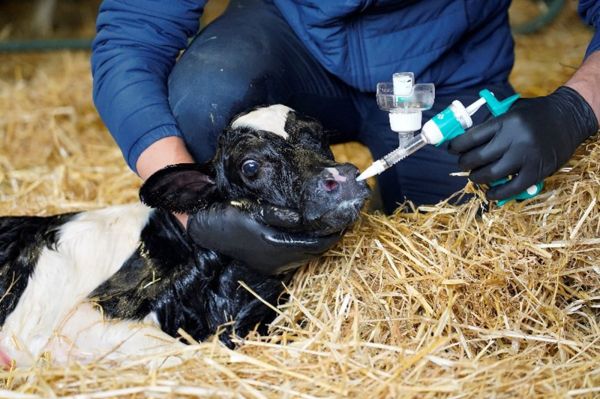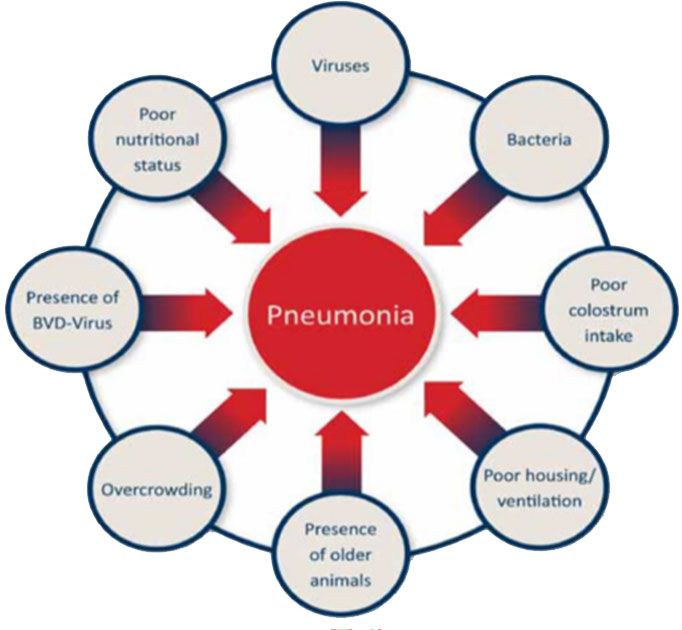Pneumonia – getting ahead of the game

Calving season is well and truly upon us once again, and a busy period lies ahead on farm. Disease outbreaks in the calf shed can be an unwelcome, stressful and costly problem. Bovine respiratory disease (BRD), or pneumonia, continues to be one of the most common disease entities on Irish farms, accounting for 38.8 per cent of deaths in one-to five-month-old calves. Calves in their first month of life are also at risk, with 11 per cent of deaths in this age group attributable to BRD.1 These figures have increased from 2022 to 2023 by 4.6 per cent and 3 per cent, respectively.
Pneumonia’s impact
Pneumonia is a multifactorial disease, meaning that calf immunity, environment, management and many different viruses and bacteria can all have a role to play in an outbreak of disease. Stress is a common trigger for it – moving or mixing calves, cold temperatures, dietary changes or disbudding can be high risk activities as stress reduces the ability of the immune system to fight disease.
Viruses such as RSV, PI3 and bovine coronavirus take advantage of a weakened immune system and may invade the respiratory system, damaging the lung tissue and making it easier for bacteria such as Mannheimia haemolytica to multiply.
Infectious bovine rhinotracheitis (IBR) is another viral disease that causes inflammation of the upper airway. Once an animal becomes infected with IBR, they remain a lifelong carrier and may shed the virus at times of stress, acting as a constant source of infection in the herd.
It is the damage to the airways, along with the inflammatory response of the animal as it tries to fight the infection, that causes the visible signs of illness in affected calves such as reduced feed intake, fever, coughing, panting and nasal discharge. Secondary bacterial infection is often severe and may be fatal. Diagnosis of what diseases are involved requires laboratory analysis of samples taken by your vet.

Figure 1. The multifactorial nature of calf pneumonia.
Source: Animal Health Ireland.
Cost of calf pneumonia?
The cost of dealing with a BRD outbreak is not to be underestimated. Immediate expenses such as vet bills, medicines and labour inputs may seem significant, however, it is the long-term effect on lifetime productivity of affected animals that has the biggest economic impact. Pre-weaning growth rates decrease by eight percent for calves experiencing pneumonia. Beef calves can suffer losses of up to 202g average daily liveweight gain (ADLWG) after severe respiratory illness, resulting in longer finishing periods and impaired carcass quality.2 Dairy heifers with a history of lung damage in the first eight weeks of life have a 525kg decrease in milk production in their first lactation on average.3 UK research estimates the total lifetime cost of respiratory disease to be approximately £772 (~€934) for affected dairy heifers; £327 (~€395) for dairy-bred beef and £263 (~€318) for beef suckler calves.2
Outbreaks of pneumonia in the calf shed not only affect the sick animals, but their pen mates too. Whilst these cohorts may not show any clinical signs of disease, they may be also infected and have hidden lung damage. Visibly affected animals are often just the tip of the iceberg. Given the significant short and long-term impacts that this common issue has on the efficiency and productivity of our herds, it makes economic sense to adopt a preventative approach to protect our young calves.
How can we control BRD?
Minimising infectious pressure
Control of calfhood illness relies on maximising calf immunity while minimising infectious pressure, i.e. exposure to disease. It is impossible to eliminate viruses and bacteria on-farm, but management practices can help to significantly reduce the build-up of these bugs in the environment.
Maintaining good hygiene in the calving pen will help to reduce disease exposure of the vulnerable newborn calf, as many bugs are shed from the cow at this time. Removing the calf from this area immediately after birth is also beneficial in this regard, as is keeping calves in a separate airspace to older stock.
Calf housing is also an important area to consider when trying to minimise infectious pressure. Wet and dirty bedding can be a breeding ground for viruses and bacteria, as well as acting as a calf stressor by reducing lying time and drawing body heat from the calf. In addition, wet bedding contributes to increased humidity in the shed, favouring disease. In situations where ventilation is suboptimal, issues can be minimised by reducing the stocking rate. A minimum of 1.5m2 floor space is required per calf, with 2.5m2 per calf being preferable. Calculating the peak number of calves you expect to house and working out the floor space you have available is a worthwhile exercise pre-calving, so that plans can be put in place to utilise alternative accommodation if needed.
Maximising calf immunity
Young calves need a robust immune system to fight off disease challenges. Colostrum is the most important contributor to calf immunity. Aim to feed three to four litres of high-quality, first-milking colostrum to each calf within two hours of birth, using clean equipment to minimise disease spread. Prolonged feeding of transition milk, the milk following colostrum before the cow produces whole milk (approximately milkings two to six) also has a positive effect of calf immunity.4
Minimising stress is the next step to improve calf immunity. Well-fed calves are better able to fight disease. Aim to feed a minimum of 15 per cent of the bodyweight of the calf per day in transition milk or good quality milk replacer. Increase amounts being fed by one litre for every 10-degree Celsius drop in temperature below 15 degrees Celsius to avoid energy deficits – a thermometer in the calf shed is a useful tool to monitor this. Keeping bedding clean and dry, providing plentiful straw for nesting and minimising draughts also helps calves to maintain body temperature and stay healthy. Providing access to clean water at all times is essential. Other ways to minimise stress include pain management at time of disbudding, minimising re-grouping and separating stressful events such as disbudding, dietary changes and change of housing.
Vaccination is a useful tool to boost calf immunity against specific infectious causes of BRD. Vaccines stimulate the animal’s immune system to produce antibodies. These antibodies help the animal to fight infection when they encounter it.
Options for vaccination
So, what vaccines should be used to protect calves against pneumonia and when? Farm-to-farm variations in calf stressors, management and causes of disease means that it depends on each farm’s individual circumstances. Your vet is often the best point of contact when formulating a plan, as they can identify unique farm risks, provide diagnostics to determine what disease may be present and advise an appropriate vaccination strategy based on all contributing factors.
Bovilis INtranasal RSP Live, providing protection against RSV and PI3, and Bovilis Nasalgen-C, providing protection against bovine coronavirus, are two live intranasal vaccines that are licensed for use from the day of birth. These vaccines may be of choice where calves are needing the earliest possible protection against viral pneumonia, or when a rapid onset of immunity is required e.g. bought-in calves.
Bovilis Bovipast RSP is an injectable vaccine that protects against RSV, PI3 and
M. haemolytica. This inactivated vaccine can be given subcutaneously from approximately two weeks of age. Bovilis Bovipast RSP can provide the broadest protection in one vaccine against viral and bacterial calf pneumonia. It can be used as a follow-on to early intranasal vaccination for comprehensive protection, or in advance of risk periods such as disbudding, castration, transport or weaning.
Bovilis IBR Marker Live provides protection against IBR (caused by BHV-1). It is a live vaccine that can be given to calves from two weeks of age by the intranasal route (and either intranasally or intramuscularly from three months of age). Bovilis IBR Marker Live can be given at the same time as Bovilis Bovipast RSP from three weeks of age.
Options for vaccination
So, what vaccines should be used to protect calves against pneumonia and when? Farm-to-farm variations in calf stressors, management and causes of disease means that it depends on each farm’s individual circumstances. Your vet is often the best point of contact when formulating a plan, as they can identify unique farm risks, provide diagnostics to determine what disease may be present and advise an appropriate vaccination strategy based on all contributing factors.
Opportunity
Along with good husbandry practices and environmental, nutritional, and concurrent disease management, early vaccination is key to increasing calf immunity in the face of respiratory disease. Protecting young calves against the insidious effects of BRD allows us to maximise their peak feed conversion efficiency prior to weaning, thus improving their lifetime productivity. We can also minimise deaths, reduce antimicrobial usage and improve animal welfare. We estimate that approximately 35 per cent of calves in Ireland received a vaccine against BRD in 2023. That leaves around 65 per cent of calves vulnerable to respiratory disease. There is a huge opportunity for us as an industry to execute early vaccination programmes and protect the future productivity and sustainability of our herds.
References
1. All Island Disease Surveillance Report 2023.
2. Bartram DJ et al. (2017). Estimating the Lifetime Total Economic Costs of Respiratory Disease in Beef And Dairy Calves in the UK. Value in Health. Volume 20, Issue 9, A643.
3. Dunn TR, Ollivett TL, Renaud DL, et al. (2017). The effect of lung consolidation, as determined by ultrasonography, on first lactation milk production in Holstein dairy calves. Journal of Dairy Science 101: 5404-5410.
4. Denholm, K. (2024). Benefits of extended colostrum feeding in dairy calves and how to implement it on farm. In Practice, 46: 380-387.




